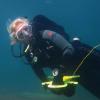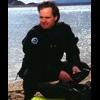Sorry Trace, I don't have the details. I seem to remember it was an instructor in California and I believe the mix was around 50%. It's not an urban legend.
Yes it is a true story and it was an instructor -- it happened in San Diego -- on 80% -- here is what Mike Kane wrote about it in Rec.Scuba on June 7, 2000 --
------------------------------------------------------------------------------------------
The story is true. It happened to a friend of mine. His name is John Cain
and I spoke with him yesterday in the hospital.
The 80% issue aside for a minute ( I'll get to that later ), he sounded in
good spirits but he was pretty banged up. He has 1st, 2nd and 3rd degree
burns on varying parts of his body. He underwent surgery yesterday and is
expected to be hospitalized for about a week. I'll call him tomorrow and
get an update.
But as to the facts, He was working with a bunch of open water students and
was planning on doing 5 very shallow dives with different students during
the day. He wasn't even taking the gas in the water, he just wanted to
breathe it as an extra measure of protection during SIT's. He cranked on
the bottle while leaning on the back of his truck. His arm was leaning on
the 1st stage and when he opened the valve it ignited. He was using the
Atomic T1/T2 and swears that it was 02 cleaned. The tank ( AL 40 ) was in
current hydro.
His wetsuit caught on fire and by the time he was able to get the flames
extinguished he has suffered some bad burns.
The REALLY sad part of this is several fold. John is really a great guy and
there were several other diver's in the area ( from a competing shop ) and
when John was getting into the ambulance they were heard to say that he
deserved it for diving with elevated 02 mixes. Moreover, they even went on
the local news channels that evening and continued this tirade saying that
by not diving within recreational mixes that it was his own fault. Nor did
they help when he was on fire..
As soon as I know more details about the diver's and shop I'll provide them.
It's one thing not to agree with someone's diving philosophy, but it's a
completely different matter when someone is on fire to stand around and play
Monday morning quarterback. Hell, I'd even help BLACK if he get's in
trouble this weekend ;-)
As to the 80%, John and I talked about this 3 weeks ago and John ( along
with Perry Armour ) is very involved in setting up my DIR demo in San Diego
slated for July 16th. In fact when John was in L.A. a month ago his comment
to me was help de-strokify me. While it was said TIC at the time, my sense
is whether he has 80% or 100% this may still have happened. But I did tell
him that if he were on any of my trips that I would make him blend last that
evening if he insisted on 80% ;-)
Also, he did say that all O-rings were viton. As soon as I know more I'll
update.
Regards
-----------------------------------------------------------------------------------------
So there ya go! No urban legends there! (-;




















